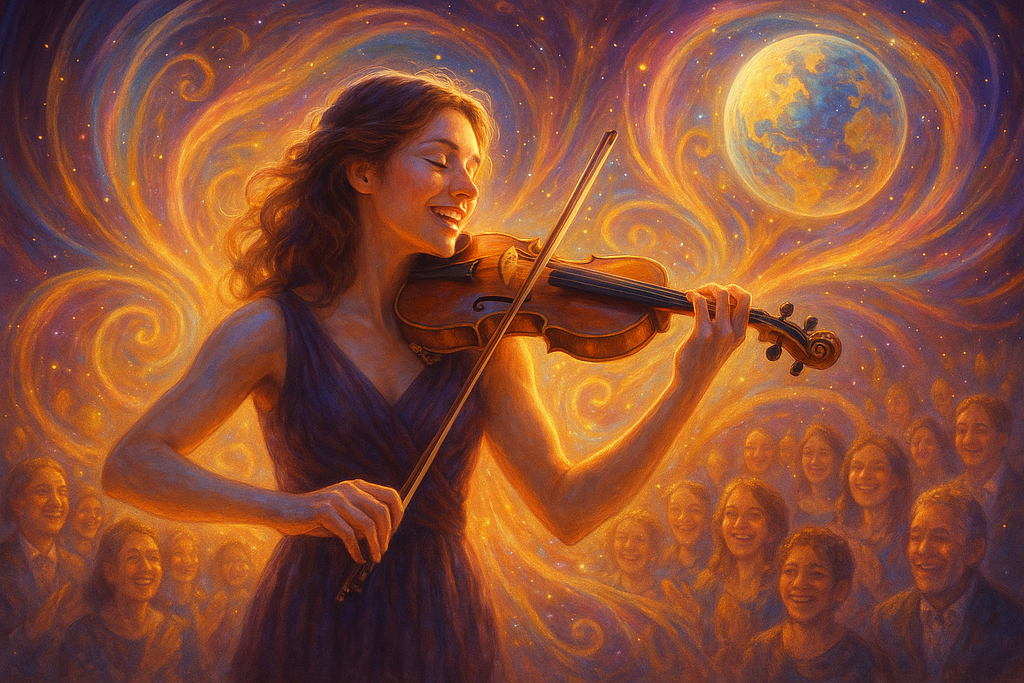“Hollywood is a place where they’ll pay you a thousand dollars for a kiss and fifty cents for your soul.”
― Marilyn Monroe
There is a direct analogy between the struggle many of us endure as children between our attachment needs and our authenticity needs, and the dissonance between the demands of our artistic gifts and the demands of survival in modern life that we as artists feel so acutely. As artists of all kinds, we have wonderful gifts we long to share with the world, but so many of us struggle to make a sufficient living from them. As described in this wonderful little video, this is a result of our “musical chairs” economy, which carries an implicit threat: if you don’t extract enough value from yourself or your surroundings, you will eventually become destitute.
Given this threat, it’s no wonder that so much human activity in modern life is directed towards maximizing profits; the more value you extract, the more cushion you have between you and homelessness. It’s also this kind of thinking that underlies usury – the lending of money at interest – which is both what drives the “world-destroying machine” and the disconnection between our love and our survival.
Usury has a complex history. Traditionally, Judaism and Islam forbade the lending of money at interest to those within the tribe. The reason for this is that the spirit of the gift had traditionally prevailed within a tribe, and to ask for extra money in return for lending it betrayed the sense of trust, generosity, and connection that such interactions might otherwise generate. But how might lending work with people who are outside the tribe? Understandably, there would be less trust of an outsider’s ability or willingness to pay the loan back for the simple reason that this person is unknown and not bound by the kinship ties and reciprocity created by a lifetime within a given tribe. In light of this, the interest paid back in addition to the principal amount of the loan is compensation for the risk taken in lending it. Thus, usury was banned within the tribe, but allowed for outsiders.
Over the millennia since such customs were developed, our worldwide civilization has grown to the point where we are surrounded by strangers, so we no longer rely very much on kinship ties and reciprocity to transact the business of our lives. Essentially, all business happens with “outsiders,” and this is reflected in the universal application of usury in our worldwide banking system. Thus we can see that mistrust and disconnection are baked into our system of the world.
Let’s illustrate this with an example. Let’s imagine that I’m a bank and you and 999 of your closest friends are my customers. Let’s also imagine that I’m the only bank in the world and that the thousand of you are only transacting with each other, such that we all form a closed economic system. At some point I decide to create money by lending a million dollars to each of you at a 10% interest rate. This means that in seven years each of you will have to pay me two million dollars in return. But how does this happen, given that everyone is only given one million, but now owes two million? You all could try to earn it from each other, and, to begin with, that would be perfectly fine because each of you would be incentivized to create things you all want and need in exchange for money.
The big problem, of course, is that not everyone can make more money from everyone else. After those seven years, some will be able to pay the two million back, but some may have only broken even, and at most only half can pay me back in full – the rest go bankrupt.
Money in our system acts very much like this because it is created as interest-bearing debt, which means that there is always more debt than money to pay that debt back. In our system, it isn’t actually the case that half the people go bankrupt because more money is always lent into existence. By the time seven years rolls around, I’ve already created enough money for almost everybody to pay me back – not quite everyone, though, because those who are disadvantaged, oppressed, lazy, incompetent, have gotten sick, or are just plain unlucky have fallen through the cracks. Although these people won’t have enough money to pay me back, we avoid mass defaults on debt because I keep lending new money into existence to help you all pay back the old money. Does this all seem like a gigantic Ponzi scheme? That’s because it is.
Here’s a key point: I don’t lend to just anyone. I only want to lend money to those who I think can pay me back. If you want my money, you have to have a business plan, collateral, a job, or co-signers. If you want a million dollars to protect coral reefs, I’ll ask how you’ll be able to pay me back. But because such a project can’t make a profit, I won’t lend you the money. If, however, you wanted a million dollars to start drilling for oil in the coral reef, I would gladly lend you the money because I know I’m going to make my money back and then some. And if I don’t do it, some other bank will – there is a decided “tilt” to this playing field.
This is the source of financial capital in our world. It is the source of salaries, the excess of unnecessary consumer items, of economic colonization, predatory lending, the maximization of profits, and ecological, cultural, personal, and spiritual devastation – all of which counts as economic growth. This dynamic is exactly what pits our idealism against our economic necessity.
Given this tilt to our economic playing field, we can begin to see why artists have it so hard in our world. For example, if I want to put on a play cheaply and efficiently, with the bare minimum set, costumes, rehearsals, and number of actors, I might be able to do it for $10,000. But if I wanted to do it really beautifully, in a way that really lit up my soul, it would cost $20,000, and because I probably can’t monetize all that extra beauty (because there are only so many seats in the theater, or so many patrons willing to sponsor the program) it just wouldn’t be economically feasible to do so.
Not all societies have valued money above all else. We just need to look at the architecture of the old sections of cities the world over and we see beauty that is not confined to the merely practical or functional – the people who financed all of this had to value beauty over financial self-interest to build these old beautiful buildings. But look at our architecture today – modern architecture is uniformly drab, ugly, and forgettable. Today, we are all trapped in a system which incentivizes ugliness, but our hearts all yearn for something else; every person on this planet yearns to do work as beautifully as they can do it, to make it better and more beautiful than it has to be, better than it has to be for the teacher, for the grade, or the paycheck. We want to do it right, to do it well, to serve the fulfillment and spirit of the thing being done. Our souls long for this, but we live in a system that discourages this at nearly every turn. This is the great dilemma for the artist in all of us.
When we look back at the great works of music and art in the past, we can see that nearly all of them were created by artists who had patrons. Mozart, Michelangelo, and all the rest needed patrons because they were not meeting quantifiable needs – they weren’t composing advertising jingles or painting ceilings in apartment buildings, for example. Ultimately, it might be the case that we, as a civilization, need to move back to a patronage model, where those who are meeting quantifiable needs subsidize everybody else out of a desire to fulfill certain values, such as ensuring our cities are beautiful places to inhabit because beauty is understood to be important to a life well-lived.
What’s “100 Days of Soulforce”? I’m embarking on a mission to spread the word about Soulforce Performing Arts because I believe it is a needed message for artists of all kinds in our times. To that end, I’m making 100 videos over the coming 100 days (or so) to explain all the different angles and ideas, and to hopefully spark inspiration in you! Each video will have inspirational and practical ideas for you to bring more Soulforce to your life as a performing artist.
These ideas are a part of my upcoming book: “Soulforce Performance Arts: Redefining Artistic Performance, Practice, and Pedagogy in a World That’s Lost Its Mind.” Subscribers to my newsletter will get early access and special perks. 🙂
Joseph Arnold Violinist, Alexander Technique teacher, Founder of the Soulforce Arts Academy
JosephArnold.com — Sign up for my bodacious mailing list and blog!
Image credit: Mathieu Stern on Unsplashunsplash.com/photos/1zO4O3Z0UJA



